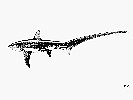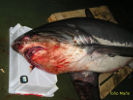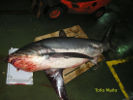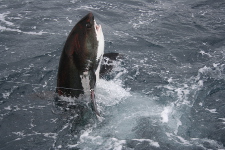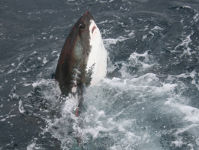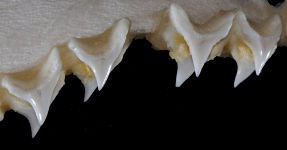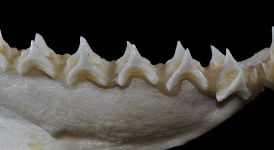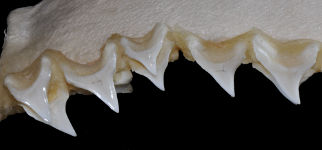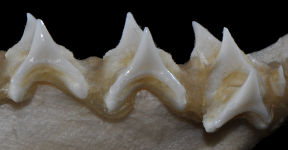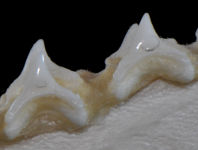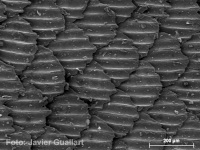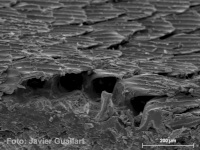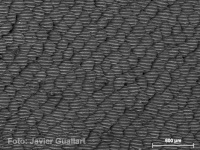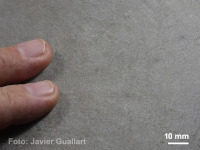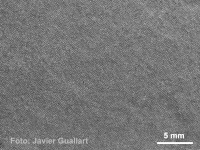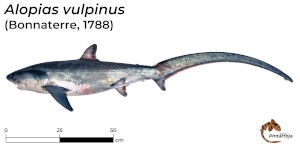Alopias vulpinus
(Bonnaterre, 1788)
Thintail thresher
Classification: Elasmobranchii Lamniformes Alopiidae
Reference of the original description
Ichthyologie. Tableau encyclopédique et méthodique des trois règnes de la nature. Paris, 215 p., pl. A–B + 1–100.
Ichthyologie. Tableau encyclopédique et méthodique des trois règnes de la nature. Paris, 215 p., pl. A–B + 1–100.
Image of the original description
.jpg)
Alopias vulpinus (Bonnaterre, 1788)
.jpg)
Alopias vulpinus (Bonnaterre, 1788)
Synonyms / new combinations and misspellings
Alopecias barrae, Alopecias chilensis, Alopecias longimana, Alopecias vulpes, Alopias aff. vulpinus, Alopias caudatus, Alopias cf. vulpinus, Alopias greyi, Alopias macrourus, Alopias vulpes, Alopias vulpines, Alopias vulpinnis, Carcharias vulpes, Galeus vulpecula, Squalus alopecias, Squalus vulpes, Squalus vulpinus, Vulpecula marina
Alopecias barrae, Alopecias chilensis, Alopecias longimana, Alopecias vulpes, Alopias aff. vulpinus, Alopias caudatus, Alopias cf. vulpinus, Alopias greyi, Alopias macrourus, Alopias vulpes, Alopias vulpines, Alopias vulpinnis, Carcharias vulpes, Galeus vulpecula, Squalus alopecias, Squalus vulpes, Squalus vulpinus, Vulpecula marina
Types
Alopias vulpinus
XXXX: No types known;
Alopias caudatus
Holotype: NMV: 58434 Paratype: NMNZ: ?
Alopias greyi
Holotype: AMNH: ?
Alopias macrourus
XXXX: No types known;
Galeus vulpecula
XXXX: No types known;
Squalus alopecias
XXXX: No types known;
Squalus vulpes
XXXX: No types known;
Vulpecula marina
Holotype: MCZ: 1166-S;
Alopias vulpinus
XXXX: No types known;
Alopias caudatus
Holotype: NMV: 58434 Paratype: NMNZ: ?
Alopias greyi
Holotype: AMNH: ?
Alopias macrourus
XXXX: No types known;
Galeus vulpecula
XXXX: No types known;
Squalus alopecias
XXXX: No types known;
Squalus vulpes
XXXX: No types known;
Vulpecula marina
Holotype: MCZ: 1166-S;
Description :
Citation: Alopias vulpinus (Bonnaterre, 1788): In: Database of modern sharks, rays and chimaeras, www.shark-references.com, World Wide Web electronic publication, Version 12/2025
Please send your images of "Alopias vulpinus" to info@shark-references.com
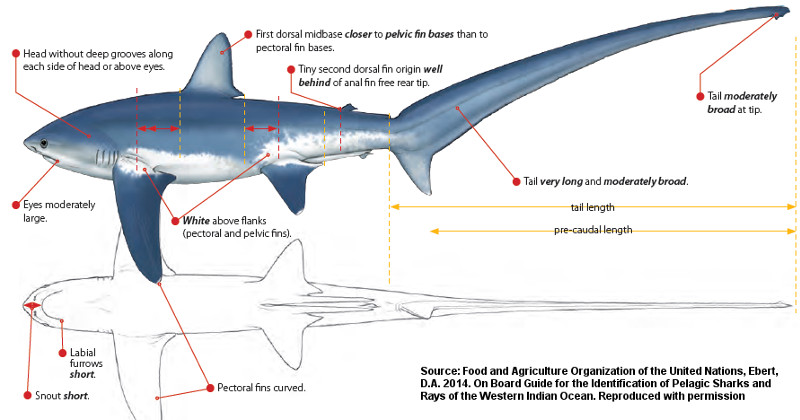
Alopias vulpinus (Bonnaterre, 1788); © FAO, Food and Agriculture Organization of the United Nations, Ebert, D.A. 2014. On Board Guide for the Identification of Pelagic Sharks and Rays of the Western Indian Ocean. Reproduced with permission, illustration by Marc Dando , Wildlife Illustrator

Alopias vulpinus (Bonnaterre, 1788); © FAO, Food and Agriculture Organization of the United Nations, Ebert, D.A. 2014. On Board Guide for the Identification of Pelagic Sharks and Rays of the Western Indian Ocean. Reproduced with permission, illustration by Marc Dando , Wildlife Illustrator
Common names
 Drescher,
Drescher,  Drescherhai,
Drescherhai,  Fuchshai,
Fuchshai,  Langschweif,
Langschweif,  Seefuchs,
Seefuchs,  Azotador,
Azotador,  Chichi espada,
Chichi espada,  Coleto,
Coleto,  Coludo,
Coludo,  Coludo pinto,
Coludo pinto,  Grillo,
Grillo,  Guadaña,
Guadaña,  Peje sable,
Peje sable,  Peje zorra,
Peje zorra,  Peje zorro,
Peje zorro,  Pejerrabo,
Pejerrabo,  Pejezorro,
Pejezorro,  Pez espada,
Pez espada,  Pez palo,
Pez palo,  Pez zorro,
Pez zorro,  Pichirata,
Pichirata,  Rabo de zorra,
Rabo de zorra,  Raposa,
Raposa,  Raposa marina,
Raposa marina,  Tiburon zorro,
Tiburon zorro,  Tiburón pez zorro,
Tiburón pez zorro,  Tiburón zorro común,
Tiburón zorro común,  Zorra de mar,
Zorra de mar,  Zorro,
Zorro,  Zorro blanco,
Zorro blanco,  Zorro de mar,
Zorro de mar,  Faux,
Faux,  Loup de mer,
Loup de mer,  Poisson-épée,
Poisson-épée,  Pèis rato,
Pèis rato,  Renard,
Renard,  Renard de mer,
Renard de mer,  Renard marin,
Renard marin,  Requin renard,
Requin renard,  Requin-renard,
Requin-renard,  Singe de mer,
Singe de mer,  Thon blanc,
Thon blanc,  Atlantic thresher,
Atlantic thresher,  Big-eye thresher,
Big-eye thresher,  Common thresher,
Common thresher,  Fox shark,
Fox shark,  Grayfish,
Grayfish,  Green thresher,
Green thresher,  Sea fox,
Sea fox,  Slasher,
Slasher,  Swingletail,
Swingletail,  Swiveltail,
Swiveltail,  Swivetail,
Swivetail,  Thintail thresher,
Thintail thresher,  Thrasher,
Thrasher,  Thresher,
Thresher,  Thresher shark,
Thresher shark,  Tresher shark,
Tresher shark,  Whip-tailed shark,
Whip-tailed shark,  Zorro thresher shark,
Zorro thresher shark,  Pei ratu,
Pei ratu,  Pesce bandiera,
Pesce bandiera,  Pesce pavone,
Pesce pavone,  Pesce spada,
Pesce spada,  Pesce volpe,
Pesce volpe,  Pesce volpe comune,
Pesce volpe comune,  Pesciu rattu,
Pesciu rattu,  Pisce bandiera,
Pisce bandiera,  Pisci bannera,
Pisci bannera,  Pisci cuda longa,
Pisci cuda longa,  Pisci cudutu,
Pisci cudutu,  Pisci sciabula turca,
Pisci sciabula turca,  Pisci surci,
Pisci surci,  Sorcio,
Sorcio,  Squalo volpe,
Squalo volpe,  Surci "mperiali,
Surci "mperiali,  Volpe,
Volpe,  Volpe de mar,
Volpe de mar,  Volpe di mare,
Volpe di mare,  Cacao-raposa,
Cacao-raposa,  Cação-pena,
Cação-pena,  Peixe-rato,
Peixe-rato,  Rabilongo,
Rabilongo,  Raposo,
Raposo,  Romano,
Romano,  Romão,
Romão,  Tubarao-raposo,
Tubarao-raposo,  Tubarão raposo,
Tubarão raposo,  Tubarão-raposa,
Tubarão-raposa,  Tubarão-zorra,
Tubarão-zorra,  Tubarão-zorro,
Tubarão-zorro,  Zoro cauda longa,
Zoro cauda longa,  Zorra,
Zorra,  Zorro, Pixxivolpi (malta)
Zorro, Pixxivolpi (malta)
 Drescher,
Drescher,  Drescherhai,
Drescherhai,  Fuchshai,
Fuchshai,  Langschweif,
Langschweif,  Seefuchs,
Seefuchs,  Azotador,
Azotador,  Chichi espada,
Chichi espada,  Coleto,
Coleto,  Coludo,
Coludo,  Coludo pinto,
Coludo pinto,  Grillo,
Grillo,  Guadaña,
Guadaña,  Peje sable,
Peje sable,  Peje zorra,
Peje zorra,  Peje zorro,
Peje zorro,  Pejerrabo,
Pejerrabo,  Pejezorro,
Pejezorro,  Pez espada,
Pez espada,  Pez palo,
Pez palo,  Pez zorro,
Pez zorro,  Pichirata,
Pichirata,  Rabo de zorra,
Rabo de zorra,  Raposa,
Raposa,  Raposa marina,
Raposa marina,  Tiburon zorro,
Tiburon zorro,  Tiburón pez zorro,
Tiburón pez zorro,  Tiburón zorro común,
Tiburón zorro común,  Zorra de mar,
Zorra de mar,  Zorro,
Zorro,  Zorro blanco,
Zorro blanco,  Zorro de mar,
Zorro de mar,  Faux,
Faux,  Loup de mer,
Loup de mer,  Poisson-épée,
Poisson-épée,  Pèis rato,
Pèis rato,  Renard,
Renard,  Renard de mer,
Renard de mer,  Renard marin,
Renard marin,  Requin renard,
Requin renard,  Requin-renard,
Requin-renard,  Singe de mer,
Singe de mer,  Thon blanc,
Thon blanc,  Atlantic thresher,
Atlantic thresher,  Big-eye thresher,
Big-eye thresher,  Common thresher,
Common thresher,  Fox shark,
Fox shark,  Grayfish,
Grayfish,  Green thresher,
Green thresher,  Sea fox,
Sea fox,  Slasher,
Slasher,  Swingletail,
Swingletail,  Swiveltail,
Swiveltail,  Swivetail,
Swivetail,  Thintail thresher,
Thintail thresher,  Thrasher,
Thrasher,  Thresher,
Thresher,  Thresher shark,
Thresher shark,  Tresher shark,
Tresher shark,  Whip-tailed shark,
Whip-tailed shark,  Zorro thresher shark,
Zorro thresher shark,  Pei ratu,
Pei ratu,  Pesce bandiera,
Pesce bandiera,  Pesce pavone,
Pesce pavone,  Pesce spada,
Pesce spada,  Pesce volpe,
Pesce volpe,  Pesce volpe comune,
Pesce volpe comune,  Pesciu rattu,
Pesciu rattu,  Pisce bandiera,
Pisce bandiera,  Pisci bannera,
Pisci bannera,  Pisci cuda longa,
Pisci cuda longa,  Pisci cudutu,
Pisci cudutu,  Pisci sciabula turca,
Pisci sciabula turca,  Pisci surci,
Pisci surci,  Sorcio,
Sorcio,  Squalo volpe,
Squalo volpe,  Surci "mperiali,
Surci "mperiali,  Volpe,
Volpe,  Volpe de mar,
Volpe de mar,  Volpe di mare,
Volpe di mare,  Cacao-raposa,
Cacao-raposa,  Cação-pena,
Cação-pena,  Peixe-rato,
Peixe-rato,  Rabilongo,
Rabilongo,  Raposo,
Raposo,  Romano,
Romano,  Romão,
Romão,  Tubarao-raposo,
Tubarao-raposo,  Tubarão raposo,
Tubarão raposo,  Tubarão-raposa,
Tubarão-raposa,  Tubarão-zorra,
Tubarão-zorra,  Tubarão-zorro,
Tubarão-zorro,  Zoro cauda longa,
Zoro cauda longa,  Zorra,
Zorra,  Zorro, Pixxivolpi (malta)
Zorro, Pixxivolpi (malta)
Short Description
A large thresher with relatively small eyes, curved, narrow-tipped pectoral fins, a narrow-tipped caudal fin, and a conspicuous white patch over the pectoral fin bases [536]. Second dorsal origin well behind the rear tip of the pelvic fin (Ref. 559). Upper lobe of caudal fin very long and strap-like, about as long as or longer than length of rest of shark; lower lobe short but well developed [20050]. Brown, grey, blue-grey, or blackish on back and underside of snout, lighter on sides and abruptly white below; a white area extends from the abdomen over the pectoral-fin bases; pectoral-, pelvic-, and dorsal fins blackish, white dots sometimes present on pectoral-, pelvic-, and caudal- fin tips [20050]. Diet: US. Pacific Coast (data base: 165 stomachs examined, 107 contained food representing a total of 20 taxa): northern anchovy (Engraulis mordax) was the most important in the diet (GI1 = 48.2), followed by Pacific hake (Merluccius productus; GI1 = 31.2), Pacific mackerel (Scomber japonicus; GI1 = 24.8), and Pacific sardine (Savdinops sagax; GI1 = 9.2). Of the invertebrates, squid (Teuthoidea, including Loligo opalescenr; GI1 = 6.3), and pelagic red crab (Pleuroncodes planipes; GI1 = 6.6), were also important. [13743]; US. Pacific Coast (difference bettween an cool-water oceanographic regime, July 1999 through May 2000 and an warm-water/transitional period, August 1998 through January 1999): Of the samples examined from the cool-water period, only 8 prey taxa were found, revealing a narrower trophic spectrum than found during the previous warmwater/ transitional period, when 20 prey taxa were identified. As in the warm-water/transitional period, northern anchovy (Engraulis mordax) was the most important overall prey, even more dominant than in the previous period. Additionally, market squid (Loligo opalescens) was second in importance and dramatically more prevalent in the cool-water period than in the warm-water/transitional period. Other important diet items in the cool-water period, in descending order of importance, were “unidentified teleosts”; Pacific sardine (Sardinops sagax); Pacific hake (Merluccius productus); and Pacific or chub mackerel (Scomber japonicus): these were also among the top six items in the previous warm-water/transitional period. [16893];
A large thresher with relatively small eyes, curved, narrow-tipped pectoral fins, a narrow-tipped caudal fin, and a conspicuous white patch over the pectoral fin bases [536]. Second dorsal origin well behind the rear tip of the pelvic fin (Ref. 559). Upper lobe of caudal fin very long and strap-like, about as long as or longer than length of rest of shark; lower lobe short but well developed [20050]. Brown, grey, blue-grey, or blackish on back and underside of snout, lighter on sides and abruptly white below; a white area extends from the abdomen over the pectoral-fin bases; pectoral-, pelvic-, and dorsal fins blackish, white dots sometimes present on pectoral-, pelvic-, and caudal- fin tips [20050]. Diet: US. Pacific Coast (data base: 165 stomachs examined, 107 contained food representing a total of 20 taxa): northern anchovy (Engraulis mordax) was the most important in the diet (GI1 = 48.2), followed by Pacific hake (Merluccius productus; GI1 = 31.2), Pacific mackerel (Scomber japonicus; GI1 = 24.8), and Pacific sardine (Savdinops sagax; GI1 = 9.2). Of the invertebrates, squid (Teuthoidea, including Loligo opalescenr; GI1 = 6.3), and pelagic red crab (Pleuroncodes planipes; GI1 = 6.6), were also important. [13743]; US. Pacific Coast (difference bettween an cool-water oceanographic regime, July 1999 through May 2000 and an warm-water/transitional period, August 1998 through January 1999): Of the samples examined from the cool-water period, only 8 prey taxa were found, revealing a narrower trophic spectrum than found during the previous warmwater/ transitional period, when 20 prey taxa were identified. As in the warm-water/transitional period, northern anchovy (Engraulis mordax) was the most important overall prey, even more dominant than in the previous period. Additionally, market squid (Loligo opalescens) was second in importance and dramatically more prevalent in the cool-water period than in the warm-water/transitional period. Other important diet items in the cool-water period, in descending order of importance, were “unidentified teleosts”; Pacific sardine (Sardinops sagax); Pacific hake (Merluccius productus); and Pacific or chub mackerel (Scomber japonicus): these were also among the top six items in the previous warm-water/transitional period. [16893];
Distribution
Cosmopolitan in temperate and tropical seas [1388]. Western Atlantic: Newfoundland, Canada to Cuba, Gulf of Mexico, Venezuela, Brazil to Argentina. Eastern Atlantic: Norway and British Isles to the Mediterranean, Morocco, Ghana and Côte d"quot;Ivoire; also Cape Province, South Africa. Indo-Pacific: scattered localities from the Gulf of Aden and East Africa to the Hawaiian, Society and Fanning islands. Eastern Pacific: Canada to Chile. Population considered reduced (R) in the US Atlantic waters; lower risk/conservation dependent (LR/CD) in US Pacific waters; data deficient (DD) in the rest of Atlantic and rest of Pacific [20064]. Highly migratory species, Annex I of the 1982 Convention on the Law of the Sea [20076]. Source: www.gbif.org
Cosmopolitan in temperate and tropical seas [1388]. Western Atlantic: Newfoundland, Canada to Cuba, Gulf of Mexico, Venezuela, Brazil to Argentina. Eastern Atlantic: Norway and British Isles to the Mediterranean, Morocco, Ghana and Côte d"quot;Ivoire; also Cape Province, South Africa. Indo-Pacific: scattered localities from the Gulf of Aden and East Africa to the Hawaiian, Society and Fanning islands. Eastern Pacific: Canada to Chile. Population considered reduced (R) in the US Atlantic waters; lower risk/conservation dependent (LR/CD) in US Pacific waters; data deficient (DD) in the rest of Atlantic and rest of Pacific [20064]. Highly migratory species, Annex I of the 1982 Convention on the Law of the Sea [20076]. Source: www.gbif.org
Human uses
fisheries: commercial; gamefish: yes
fisheries: commercial; gamefish: yes
Biology
Ovoviviparous, embryos feed solely on the ova produced by the mother after the yolk sac is absorbed (oophagy) [733], 2 to 4 young in a litter (usually 2) [518]. Size at birth 114-150 cm [518]. Distinct pairing with embrace [17086]. Occurs on the continental shelf and slope (Ref. 75154).
Ovoviviparous, embryos feed solely on the ova produced by the mother after the yolk sac is absorbed (oophagy) [733], 2 to 4 young in a litter (usually 2) [518]. Size at birth 114-150 cm [518]. Distinct pairing with embrace [17086]. Occurs on the continental shelf and slope (Ref. 75154).
Size / Weight / Age
760 cm TL (male/unsexed; (Ref. 6885)); 549 cm TL (female); max. published weight: 348.0 kg (Ref. 40637); max. reported age: 19 years [2246]
760 cm TL (male/unsexed; (Ref. 6885)); 549 cm TL (female); max. published weight: 348.0 kg (Ref. 40637); max. reported age: 19 years [2246]
Habitat
pelagic-oceanic; oceanodromous [17660]; marine; depth range 0 - 550 m [578], usually 0 - 200 m (Ref. 55168)
pelagic-oceanic; oceanodromous [17660]; marine; depth range 0 - 550 m [578], usually 0 - 200 m (Ref. 55168)
Remarks
shark-references Species-ID=198; CITES: (see: Protected Species for more details) Convention on International Trade in Endangered Speciesof Wild Fauna and Flora annex: II; Council Regulation 2017/160 annex: B
shark-references Species-ID=198; CITES: (see: Protected Species for more details) Convention on International Trade in Endangered Speciesof Wild Fauna and Flora annex: II; Council Regulation 2017/160 annex: B
Parasites (arranged by Jürgen Pollerspöck)
Monogenea
Cestoda
Trematoda
Nematoda
Acanthocephala
Copepoda
Monogenea
Cestoda
- Clistobothrium sp. [28988]
- Hepatoxylon trichiuri (Holten, 1802) [16112]
- Heterosphyriocephalus tergestinus (Pintner, 1913) [16112] [25091]
- Lacistorhynchus dollfusi Beveridge & Sakanari, 1987 [28715]
- Lacistorhynchus tenuis (Van Beneden, 1858) [16112]
- Molicola sp. [28715]
- Molicola uncinatus (Linton, 1924) [16129] [16112]
- Monorygma megacotyla Yamaguti, 1952 [16129]
- Orygmatobothrium musteli (Van Beneden, 1850) [15075] [16182] [25154]
- Paraorygmatobothrium sp. [28715]
- Scyphophyllidium alopias Yamaguti, 1952 [16129] [16206] [34140]
- Scyphophyllidium exiguum (Yamaguti, 1935) [16458] [16387]
- Scyphophyllidium filiforme (Yamaguti, 1952) [16129] [16443] [16200] [34140]
- Sphyriocephalus viridis (Wagener, 1854) Pintner, 1913 [16112]
Trematoda
- Campula oblonga Cobbold, 1858 [7600]
Nematoda
Acanthocephala
- Rhadinorhynchus cololabis Laurs & Mccauley, 1964 [28715]
Copepoda
- Dinemoura discrepans Cressey, 1967 [16599]
- Dinemoura producta (Müller, 1785) [16609]
- Dinemoura sp. [16583]
- Echthrogaleus denticulatus Smith, 1873 [16599] [16583]
- Gangliopus pyriformis Gerstaecker, 1854 [16583] [14330] [14327]
- Kroyerina benzorum Deets, 1987 [15948]
- Nemesis aggregatus Cressey, 1967 [16583]
- Nemesis lamna Risso, 1826 [16609] [21355]
- Nemesis robusta (Van Beneden, 1851) [16602] [15951] [16609] [15303] [27172]
- Nemesis sp. [27172]
- Nesippus orientalis Heller, 1868 [16609] [15304] [15284] [27172]
- Pandarus cranchii Leach, 1819 [16583]
- Pandarus smithii Rathbun, 1886 [16599] [16583]
- Pennella sp. [28715]








